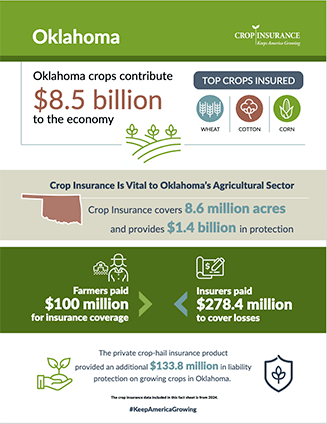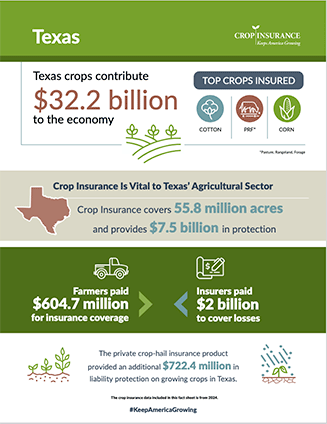Crop Insurance is purchased by agricultural producers, including farmers, ranchers, and others to protect against either the loss of their crops due to natural disasters, or the loss of revenue due to declines in the prices of agricultural commodities. There are two types of crop insurance: multi-peril and private.
Multi-Peril Crop Insurance (MPCI)
![]() MPCI policies provide coverage for loss of production or a combination of yield and price coverage provided through the Federal Crop Insurance Corporation (FCIC). These policies provide coverage to the agricultural producer for a number of naturally occurring perils and combination products also cover loss in value due to a change in market price during the insurance period. MPCI is federally supported and regulated, and is sold and serviced by private-sector crop insurance companies and agents.
MPCI policies provide coverage for loss of production or a combination of yield and price coverage provided through the Federal Crop Insurance Corporation (FCIC). These policies provide coverage to the agricultural producer for a number of naturally occurring perils and combination products also cover loss in value due to a change in market price during the insurance period. MPCI is federally supported and regulated, and is sold and serviced by private-sector crop insurance companies and agents.
Private Products
Private policies are not part of the Federal Crop Insurance Program and are provided directly to farmers by private insurers. For instance many farmers purchase Crop-Hail coverage because hail has the unique ability to totally destroy a significant part of a planted field while leaving the rest undamaged. In areas of the country where hail is a frequent event, farmers often purchase a Crop-Hail policy to protect high-yielding crops. Unlike MPCI, a Crop-Hail policy can be purchased at any time during the growing season.
Multi-Peril Crop Insurance
Annual Forage
Annual Forage
Annual Forage is a Rainfall Index insurance policy that provides coverage on any annually planted crop used for forage or fodder by livestock. This pilot program is designed to protect against a single peril, lack of precipitation. Click here to learn more.Hemp
Hemp
APH hemp is a pilot program that provides coverage against loss of yield because of insurable causes of loss for hemp grown for fiber, grain or Cannabidiol (CBD) oil. Click here to learn more.Dairy Revenue Protection
Dairy Revenue Protection
DAIRY REVENUE PROTECTION is designed to insure against unexpected declines in the quarterly revenue from milk sales relative to a guaranteed coverage level. Click here to learn more.
Enhanced Coverage Option (ECO)
Enhanced Coverage Option (ECO)
The Enhanced Coverage Option (ECO) is a new crop insurance option that provides additional area-based coverage for a portion of your underlying crop insurance policy deductible. Click to learn more.Individual Plans
Individual Plans
Individual plans– (APH, RP, & YP) are based upon an individual yield loss and, in some plans, a decline in price, due to a wide range of perils. Click here to learn more.Livestock Gross Margin (LGM)
Livestock Gross Margin (LGM)
The Livestock Gross Margin for Cattle, Swine & Dairy Insurance Policies provides protection against the loss of gross margin. Click here to learn more.Livestock Risk Protection (LRP)
Livestock Risk Protection (LRP)
Livestock Risk Protection (LRP) protects your investment should prices drop before your livestock gets to market while preserving your upside potential. Click here to learn more.Pasture, Range and Forage (PRF)
Pasture, Range and Forage (PRF)
The RI-PRF plan is designed to insure against a decline in an index value that is based on the long-term, historical, average precipitation for the same area of land for the same period of time. Click here to learn more.Quality Loss Option (QL)
Quality Loss Option (QL)
The Quality Loss Option (QL) is a new crop insurance option that you can elect starting with the 2021 crop year. Click here to learn more.Stacked Income Protection (STAX)
Stacked Income Protection (STAX)
Stacked Income Protection (STAX) is a crop insurance product for upland cotton that provides coverage for a portion of the expected revenue for your area. Click here to learn more.Supplemental Coverage Option (SCO)
Supplemental Coverage Option (SCO)
Supplemental Coverage Option (SCO) is a crop insurance option that provides additional protection of your underlying crop insurance policy deductible. Click here to learn more.Whole Farm Revenue Protection (WFRP)
Whole Farm Revenue Protection (WRFP)
Whole Farm Revenue Protection (WFRP) allows producers to cover their entire farming operation with a single insurance product. Click here to learn more.Private Products
Crop Fire
Crop Fire
Crop Fire – a stand-alone named peril product that covers fire, lightening and transit.Crop Hail
Crop Hail
Crop Hail – Hail is one peril that can decimate a portion of your field and leave the rest undamaged. Crop hail coverage gives you acre-by-acre protection up to the actual cash value of your crop, thereby protecting your investment and your future. This policy is available in a variety of forms and allows you to tailor the coverage to meet your needs.Pasture Fire Protection
Pasture Fire Protection
Pasture Fire Protection – The pasture fire protection policy covers PRF used to feed livestock. To be eligible the insured must have a documented insurable interest in the PRF ground. This policy insures the PRF ground against fire caused by direct result of lightning strike, by equipment machinery, and by weather related downed power lines. This policy is an annual policy and insureds must submit an application each year.- Plant Dates & County T-Yields
- Actuarials 2026 | 2025 | 2024
- Crop Policies 2026 | 2025
- Crop Yield Resources
- Livestock Reports
- Livestock Insurance Offer Calendar
- Policy Options & Endorsements



